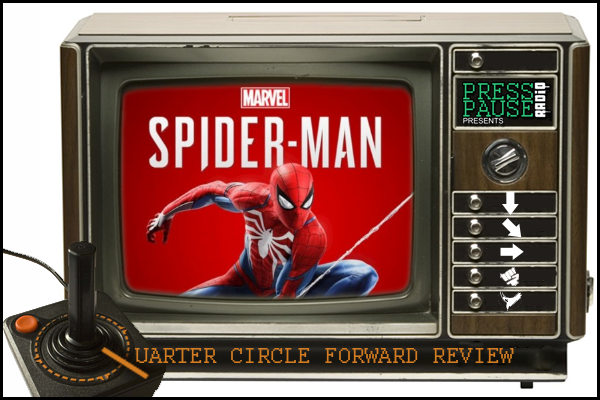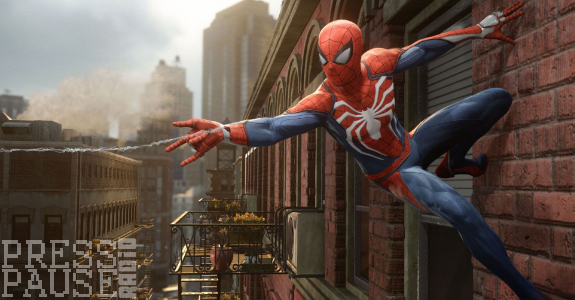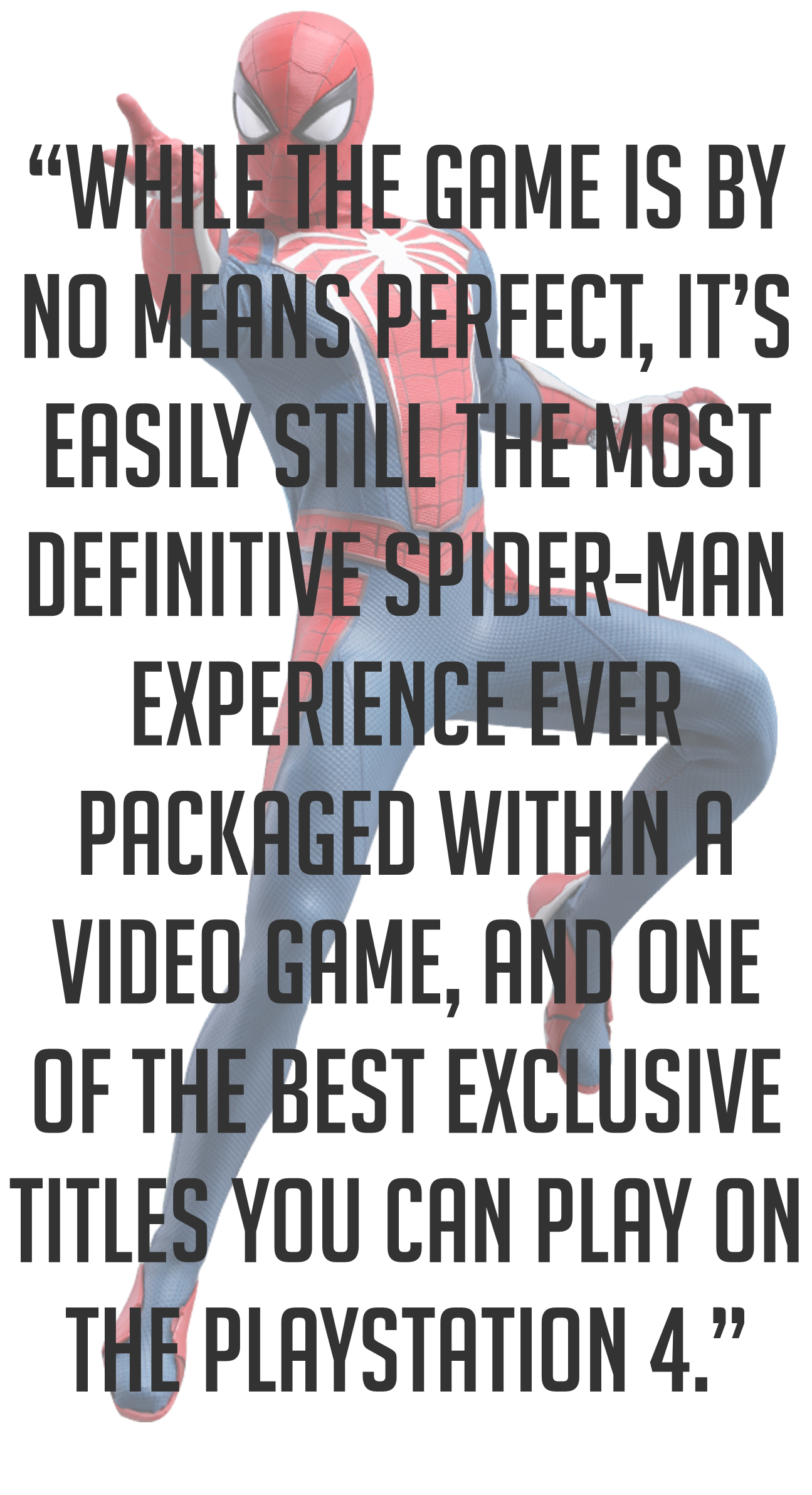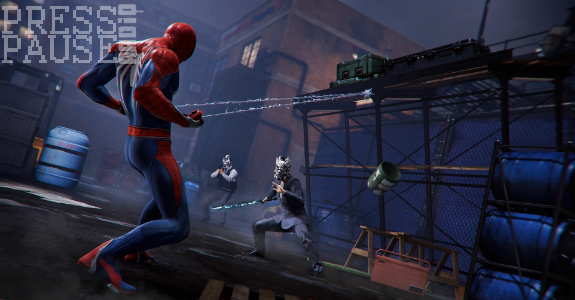
 ne of the most challenging aspects of a Superhero-driven Video Game is to emulate what it would be like for players to assume the role of said Superhero authentically. The wall-crawling teenager of comic book fame, Spider-Man, has had a storied, and admittedly mixed history of accomplishments in the gaming space, and it many of the Web-Head’s more recent titles had left the impression that he had finally peaked in terms of gaming.
ne of the most challenging aspects of a Superhero-driven Video Game is to emulate what it would be like for players to assume the role of said Superhero authentically. The wall-crawling teenager of comic book fame, Spider-Man, has had a storied, and admittedly mixed history of accomplishments in the gaming space, and it many of the Web-Head’s more recent titles had left the impression that he had finally peaked in terms of gaming.
But then Insomniac came along with an open-world approach that borrowed heavily from RockSteady’s Batman Arkham series—one that emphasizes frenetic movement that relies on all of the character flourishes that Spider-Man offered them, packed into a story-driven narrative that would push the character-action genre to the next level.
Marvel’s Spider-Man isn’t just a must-play for PlayStation 4 owners—it’s one of the most important games of this generation.
As energetic as the Marvel Icon’s outings were, a large reason for their stagnation stemmed on how formulaic they all started to be. Nearly every one of Spider-Man’s games from the last decade can be broken down into one part web-slinging, one part mob combat, then part chase sequence, etcetera, etcetera—they’re almost their own entire sub-genre of Action game with how often some of these tropes have been visited with the character. Insomniac’s approach on this tired formula was to break the mold with a formula that was bigger, but more fluid—every fundamental physic that you could associate with modern Spider-Man gameplay has been refined with a sense of realism that commands a degree of intimacy between the player and the action.

Swinging, for instance, is unlike anything it was before; gone is the omnipresent skybox that worked as a catch-all for Spidey’s arachnoid grappling, as swinging now requires web to physically cling to actual architecture in the city. Players will have to dynamically aim where their next swing is going to stick to between leaps, as web placement can, and will, significantly affect Spider-Man’s momentum and trajectory during travel. If you swing too far above the skyline, it will drastically limit the available anchor points for the next swing, forcing you to descend within the reach of a building just to propel forward. On the flipside, swinging too low to the ground could put you at risk for some high-velocity collision with any of the Manhattan traffic that the city is famous for having. The new mechanic is admittedly overwhelming at first, and it does have a bit of a learning curve that can last well over the introductory hours of the adventure, but once you’re acclimated to the rhythm of it all, this new in-depth approach to swinging just offers a new sensation to your reflexes. The swinging dynamic alone just so good in its own right that it goes to show just lacking Spider-Man gameplay has honestly been these last couple of generations.
 Engaging traversal is nothing without good level design to compliment it, and it’s here where the developers have really outdone themselves with the immaculate attention detail they gave to the digital reconstruction of New York City within Marvel’s Spider-Man. Not since Sucker-Punch’s delivery of Seattle in infamous: Second-Son has a real-world environment been depicted as accurately as New York is in this PlayStation 4 exclusive. From finding digital analogs for locales at the same cross-streets as their real-life counterparts, to seeing the public transit traveling the same rigorous schedules and routes that they do in the New York streets, the level of authenticity on display here is mind-blowing, cementing just how integral the city is to the overall Spider-Man experience.
Engaging traversal is nothing without good level design to compliment it, and it’s here where the developers have really outdone themselves with the immaculate attention detail they gave to the digital reconstruction of New York City within Marvel’s Spider-Man. Not since Sucker-Punch’s delivery of Seattle in infamous: Second-Son has a real-world environment been depicted as accurately as New York is in this PlayStation 4 exclusive. From finding digital analogs for locales at the same cross-streets as their real-life counterparts, to seeing the public transit traveling the same rigorous schedules and routes that they do in the New York streets, the level of authenticity on display here is mind-blowing, cementing just how integral the city is to the overall Spider-Man experience.
Though Combat is just as refined, is one of the low-points of the experience, especially when it’s nowhere near as innovative as the rest of the game, with it being a bit too eerily similar to another certain open-world superhero title than it honestly should be. Getting the Wall-Crawler to melee his way to victory is as simple as striking, evading, countering, and Batarang thro…oh, excuse me, web-shooting against waves upon waves of enemy mobs. What Insomniac failed to lift from the Caped-Crusader’s system, however, was proper enemy balancing—the build on some of these goons in the game and what they output is just downright broken.
Until I had was able to build enough experience to properly enhance Spidey with the skills and strengths that were needed to make a difference, I was manhandled in a way that just couldn’t be blamed on skill alone. It quickly became apparent to me that the Scarlet Spider I was fighting with was a surprisingly sturdy bullet sponge with a shockingly fragile glass-jaw; close-encounters with more than two enemies at once nearly always ended with my demise because all it two were two to three punches to plant Parker right down into the pavement. That’s not to say that the evasion mechanics were unresponsive, they absolutely are, they just leave little to room for error with classes of opponents that’re meant to be fought in close quarters. Enemies like big brutes, or shielded henchman, and getting into a scuffle with more than two of them meant made the challenge feel artificial because of how hard they hit more so than the way they hit. Unlike the learning curve that the swinging dynamics paced me through, getting the hang of combat required some cheese and exploitation with the limited arsenal given to me before I was able to acquire the abilities and buffs needed to stand more of a chance. Fighting was just far too clumsy for me throughout the majority of the adventure—a brute shouldn’t need to be whipped with multiple objects from a distance in order to increase your odds of survival, Spider-Man deserves far more finesse than that.
Once that point is reached though, the combat has its moments, especially when it comes to plethora for offensive aerial maneuvers. Whether it’s launching them into the air from the grounding, or fishing them into it from above with your web, there are loads of ways to pound on a foe while suspending gravity, and strategically, it’s one of the more effective means to clear out the opposition, especially when in a situation that calls for a stealthy approach. Anytime the combat started to get stale, the option of sticking a thug to the side of a building from the rafters, or uppercutting a chump up into space and recreating Spidey’s air-combo technique from Marvel VS Capcom almost always managed to successfully set the overall system apart from the source material that it clumsily parroted.
Ironically enough, for a character that became iconic for his storytelling and thoughtful characterization, nearly all of the software that’s based on him has admittedly failed in delivering a narrative or presentation that can live up to the expectations that Marvel’s printed media have set over the years.
When it was learned that Dan Slott would be the lead writer for the story, memories of the pandering mess that was Shattered Dimensions immediately came to mind. Thankfully, both he, and all of the other folks working with Insomniac respectively had dispelled my doubts with a refreshingly compelling take on the storied character and his supporting cast, in a story that’s refreshingly grounded, and brilliantly paced. Incorporating elements both new and old, the setup of Marvel’s Spider-Man opens at Parker’s burgeoning years into adulthood, after having donned the costume for the better part of his teenage years, and placing him at just the right crossroads to evoke everything that makes the character so likable—the fallible perseverance of Peter Parker. Little things like betting all of his professional chips on Professor Otto Octavius in a risky tech venture while struggling with the turbulence of paying his rent and the toll it takes on both him, and his vigilante persona is the tone that Spider-Man games have been desperately missing for years.

The most appealing thing about the wall-crawler has always been how human he really is in spite of his extraordinary life. The introduction of Mr. Negative and his gang of super-naturally powered gangsters known as the Demons are also welcome additions to Spidey’s rogues, creating a threat that’s gripping enough to mesmerically escalate the stakes of the game’s action without breaking the immersion of a narrative that’s beholden to the dynamics of gameplay. In spite of the poor enemy balancing that was previously mentioned, the concept of the Demons is solid enough that they could be adapted for future Spider-Man stories with how much mileage is still left in their premise even after everything is said and done in Spider-Man’s campaign. There’s so much to be said about the plot, and how it’s told, but for now, and it would be a shame to divulge any more in this review because it’s simply just that good; Marvel’s Spider-Man does a great job of harmonizing captivating story beats with enchanting characterization.
While the game is by no means perfect, it’s easily still the most definitive Spider-Man experience ever packaged within a video game, and one of the best exclusive titles you can play on the PlayStation 4. I don’t have a dumb swing pun to toss in—just be sure to install this software however you can on your PS4, and thank me later.
